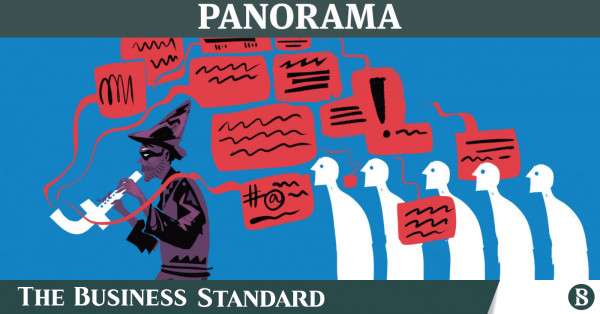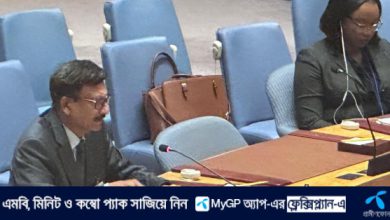Rumours run amok in the first hours of newfound freedom


After the ousting of Sheikh Hasina and in the absence of an interim government, misinformation and disinformation ran wild across social media platforms
Illustration: TBS
“>
Illustration: TBS
If you were online in the early hours of Tuesday, then you would have definitely suffered a panic attack.
There were outlandish and outrageous lies circulating, which many people were buying into. And then there were other instances where information was being grossly exaggerated.
Blurring the lines between misinformation and disinformation, social media quickly became a cynical, confusing and claustrophobic hotbed of half-truths and misleading, unverified news.
Here are some examples.
In one case, there were Facebook posts about a fire breaking out in the Gonobhobon, when in fact, a car was set on fire inside the compound. However, there was no actual case of arson inside the compound. News of Gonobhobon being set on fire can trigger chaos and fear – and that is what happened across social media.
Another rumour which spread like wildfire across social media causing hysteria was “mass graves found inside Gonobhobon.”
This happened when a Facebook video – in which the speaker says that they had discovered thousands of students’ books in foliage, and the soil was damp – surfaced on social media and became indiscriminately shared. And since there was also a rotten odour in the air, the video said there were mass graves of the students underneath.
The video shows blurry and unclear footage from inside the Gonobhobon compound.
Later, a group of journalists went there to verify the claim. Qadaruddin Shishir, a fact-checker working with the AFP, was one of them. He said, “When we went there, we realised that there was no mass grave. Perhaps a cat or a dog died in the foliage, hence the smell.”
Fear, especially when stoked by uncertainty and upheaval, can be a powerful and contagious emotion. The ousting of Sheikh Hasina and the collapse of the Awami League government left a vacuum of power and security, prompting widespread unrest. In such volatile times, people are prone to anxiety and paranoia, seeking explanations for the turmoil around them.
In the case of the attack on Hindu temples, a curious pattern emerged. In one case, a photo of a vandalised temple in Chattogram started to circulate. But later, a local man confirmed that the temple was safe. The photo was in fact from September 2022.
There were, however, cases of temple vandalisation in 29 districts across the country starting in the late hours of 5 August.
Communal violence is a real threat in the country, and at an especially vulnerable time like this, the relentless rumour mill adds to people’s confusion and fear. While there had been actual cases of attack on Hindu temples in the later hours of 5 August, several videos widely shared misinformed the public. Those videos claimed certain temples were attacked, when in fact they were not.
Again, adding to people’s hysteria and fear.
Another rumour started to circulate that the top four Bangladesh Chattro League leaders had escaped the country.
In a climate of unprecedented uncertainty as to what will happen next in Bangladesh, people rely on information from social media to gauge and predict the situation. Fake news of four top BCL leaders finding a safe exit clearly angered the people who are desperately looking for some sort of justice for what had happened in the country since 16 July.
Later, it was found that at least one of them, Tanbir Hasan Saikat, general secretary of the Chhatra League’s Dhaka University unit, was still in the country, and later detained at the airport on Tuesday. Meanwhile, the whereabouts of the other three BCL leaders remain unknown.
In a more consequential case, the baseless rumours about Indian intelligence agents – more commonly known as RAW – managed to grip the collective psyche of Bangladeshis.
The rumour about Indian agents started from a video where someone claimed that Indian spies are attacking the Bangladesh Army. Later, when sporadic shooting started across the city between the police, armed Awami League cadres and the army, people attributed the news to the Indians attacking.
Of course, the fervour calmed down as the dawn progressed.
Prior to 5 August, when the “Indian agents inside Bangladesh” found unprecedented traction on social media platforms, video of Bangladeshi policemen attacking and dragging away a citizen and speaking Hindi already started to widely circulate. This added a lot of weight to the angst among netizens. It is believed that the videos were somehow altered.
The spread of fear-mongering rumours undermines public trust and stability, creating an environment where misinformation thrives.
Qadaruddin Shishir said, “Debunking these rumours is tough, as there is hardly any evidence to use. We can debunk such rumours only if we go there and put the situation into context. Until then, we can not debunk these rumours.”
So, why did these particular rumours spread after midnight? Part of the reason is practical: fewer people are available to debunk and counter false claims during these hours. By the time the authorities or credible sources can respond, the misinformation has already taken root in the public consciousness.
Additionally, the nocturnal timing plays into the primal human fear of the unknown, making the rumours more likely to be believed and shared. The isolation of the late hours means there are fewer immediate ways to verify information, leaving people to rely on the rapidly spreading narratives on their screens.
The aftermath of a historic Monday led to panic and confusion in the absence of an interim government. And especially into the late hours of the night, the social media’s perils became amplified.
The real-life problem here is panic and confusion can lead to real-world consequences because people tend to act on their fears. The sporadic violence across Dhaka, already fueled by political upheaval, could easily escalate due to misinformation or disinformation.
Waking up on Tuesday, people started to make memes. And those who had slept early after a day of jubilation found themselves in a volatile, new Facebook landscape.




